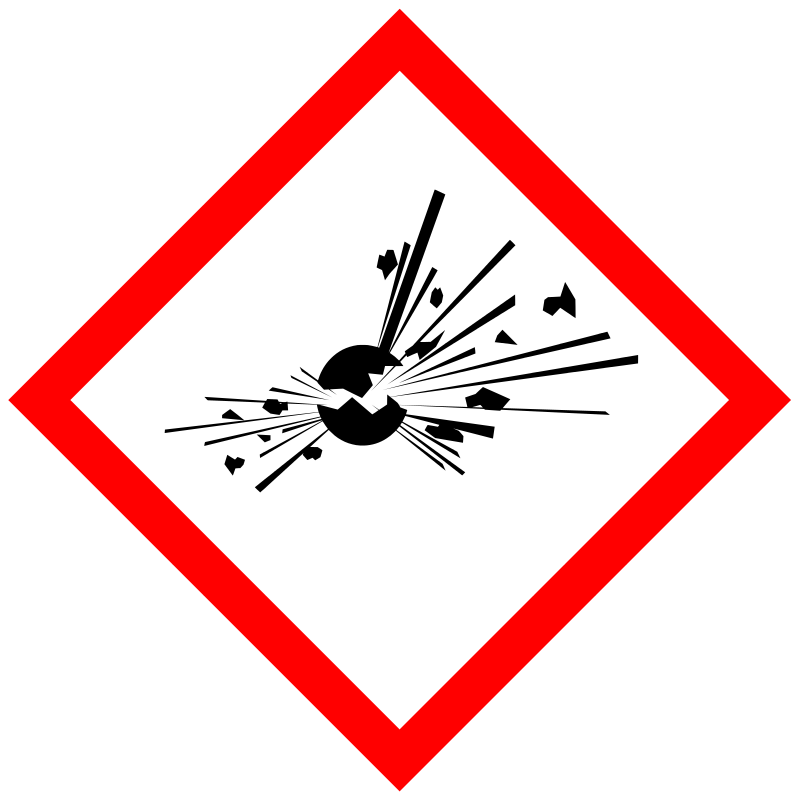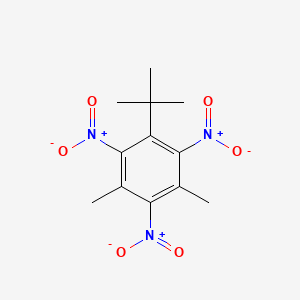D0641 | 2,4,6-trinitro-1,3-dimethyl-5-tert-butylbenzene
| Toxicity | Dose | Time | Species | Model | Method | Action | Positive criterion | Reference |
|---|---|---|---|---|---|---|---|---|
| MEMBRANE POTENTIAL | 20.09±6.09 | human | qHTS-HepG2 | MMP assay | decrease | IC50 | 163 | |
| MEMBRANE POTENTIAL | 7.94 | human | HepG2 | MMP assay | decrease | IC50 | 163 | |
| MEMBRANE POTENTIAL | rat | hepatocytes | MMP assay | Negative | IC50 | 163 | ||
| Pictogram | Signal | Statements | Precautionary Statement Codes |
|---|---|---|---|
   |
Danger |
H201: Explosive mass explosion hazard [Danger Explosives] H351: Suspected of causing cancer [Warning Carcinogenicity] H400: Very toxic to aquatic life [Warning Hazardous to the aquatic environment, acute hazard] H410: Very toxic to aquatic life with long lasting effects [Warning Hazardous to the aquatic environment, long-term hazard] |
P201, P202, P210, P230, P240, P250, P273, P280, P281, P308+P313, P370+P380, P372, P373, P391, P401, P405, and P501; (The corresponding statement to each P-code can be found at the GHS Classification page.) |
   |
Danger |
Aggregated GHS information provided by 199 companies from 8 notifications to the ECHA C&L Inventory. Each notification may be associated with multiple companies. H201 (100%): Explosive mass explosion hazard [Danger Explosives] H351 (100%): Suspected of causing cancer [Warning Carcinogenicity] H400 (100%): Very toxic to aquatic life [Warning Hazardous to the aquatic environment, acute hazard] H410 (100%): Very toxic to aquatic life with long lasting effects [Warning Hazardous to the aquatic environment, long-term hazard] Information may vary between notifications depending on impurities, additives, and other factors. The percentage value in parenthesis indicates the notified classification ratio from companies that provide hazard codes. Only hazard codes with percentage values above 10% are shown. |
P201, P202, P210, P230, P240, P250, P273, P280, P281, P308+P313, P370+P380, P372, P373, P391, P401, P405, and P501; (The corresponding statement to each P-code can be found at the GHS Classification page.) |
   |
Danger |
H201: Explosive mass explosion hazard [Danger Explosives] H351: Suspected of causing cancer [Warning Carcinogenicity] H410: Very toxic to aquatic life with long lasting effects [Warning Hazardous to the aquatic environment, long-term hazard] |
P201, P202, P210, P230, P240, P250, P273, P280, P281, P308+P313, P370+P380, P372, P373, P391, P401, P405, and P501; (The corresponding statement to each P-code can be found at the GHS Classification page.) |
  |
Warning |
H228: Flammable solid [Danger Flammable solids] H320: Causes eye irritation [Warning Serious eye damage/eye irritation] H351: Suspected of causing cancer [Warning Carcinogenicity] |
P201, P202, P210, P240, P241, P264, P280, P281, P305+P351+P338, P308+P313, P337+P313, P370+P378, P405, and P501; (The corresponding statement to each P-code can be found at the GHS Classification page.) |
| Organism | Test type | Route | Dose (normalized dose) | Effect | Source |
|---|---|---|---|---|---|
| mouse | LD50 | oral | > 4gm/kg (4000mg/kg) | Food and Chemical Toxicology. Vol. 28, Pg. 581, 1990. | |
| rat | LD50 | oral | > 10gm/kg (10000mg/kg) | Bulletin of Environmental Contamination and Toxicology. Vol. 26, Pg. 656, 1981. | |
| rabbit | LD50 | skin | > 15gm/kg (15000mg/kg) | Bulletin of Environmental Contamination and Toxicology. Vol. 26, Pg. 656, 1981. | |
| 1-(1,1-Dimethylethyl)-3,5-dimethyl-2,4,6-trinitrobenzene | 1-t-butyl-3,5-dimethyl-2,4,6-trinitrobenzene | 1-tert-Butyl-3,5-dimethyl-2,4,6-trinitrobenzene |
| 1-tert-butyl-3,5-dimethyl-2,4,6-trinitro-benzene | 1ZAO16GU5K | 2,4,6-Trinitro-1,3-dimethyl-5-t-butylbenzene |
| 2,4,6-Trinitro-1,3-dimethyl-5-tert-butylbenzene | 2,4,6-Trinitro-3,5-dimethyl-1-tert-butylbenzene | 2,4,6-Trinitro-3,5-dimethyl-tert-butylbenzene |
| 2,4,6-Trinitro-5-tert-butyl-m-xylene | 2,6-Trinitro-1,3-dimethyl-5-tert-butylbenzene | 2,6-Trinitro-3,5-dimethyl-tert-butylbenzene |
| 4-05-00-01132 (Beilstein Handbook Reference) | 5-t-Butyl-2,4,6-trinitro-m-xylene | 5-tert-Butyl-2,4,6-trinitro-m-xylene |
| 5-tert-Butyl-2,4,6-trinitro-m-xylene or musk xylene | 5-tert-Butyl-2,4,6-trinitro-m-xylene or musk xylene [UN2956] [Flammable solid] | 5-tert-Butyl-2,4,6-trinitro-m-xylene or musk xylene [UN2956] [Flammable solid] |
| 5-tert-Butyl-2,4,6-trinitroxylene | 5-tert-butyl-2,4,6-trinitro-meta-xylene | 81-15-2 |
| A840054 | AI3-09017 | AKOS015890367 |
| BENZENE, 1-(1,1-DIMETHYLETHYL)-3,5-DIMETHYL-2,4,6-TRINITRO- | BRN 2015910 | Benzene, 1-tert-butyl-3,5-dimethyl-2,4,6-trinitro- |
| Benzene,1-dimethylethyl)-3,5-dimethyl-2,4,6-trinitro- | Benzene,5-dimethyl-2,4,6-trinitro- | C19462 |
| CAS-81-15-2 | CCRIS 2391 | CHEBI:77320 |
| CHEMBL228513 | DSSTox_CID_1405 | DSSTox_GSID_21405 |
| DSSTox_RID_76143 | DTXSID1021405 | EINECS 201-329-4 |
| FT-0620779 | HSDB 7692 | LS-7740 |
| MCULE-2438654421 | MFCD00024270 | Musk xylene |
| Musk xylene 10 microg/mL in Cyclohexane | Musk xylene 100 microg/mL in Cyclohexane | Musk xylene solution, 100 mug/mL in acetonitrile, analytical standard |
| Musk xylol | Muskxylene;2,4,6-Trinitro-1,3-dimethyl-5-tert-butylbenzene;2,4,6-Trinitro-5-tert-butyl-1,3-xylene; | NCGC00255244-01 |
| NSC 59844 | NSC-59844 | NSC59844 |
| Q425330 | S184 | SCHEMBL273394 |
| Tox21_302248 | UN2956 | UNII-1ZAO16GU5K |
| XMWRWTSZNLOZFN-UHFFFAOYSA-N | Xylene musk | ZINC40454343 |
| m-Xylene, 5-tert-butyl-2,4,6-trinitro- | m-Xylene, 5-tert-butyl-2,4,6-trinitro- (8CI) |

